commentary Commentary
Commentary: Thailand as a model? Why Myanmar military may follow Prayuth's example
It would be far smarter for the Tatmadaw to build support within a pseudo-democratic system—as Thailand’s military has done, says ISEAS’ Dr Paul Chambers.
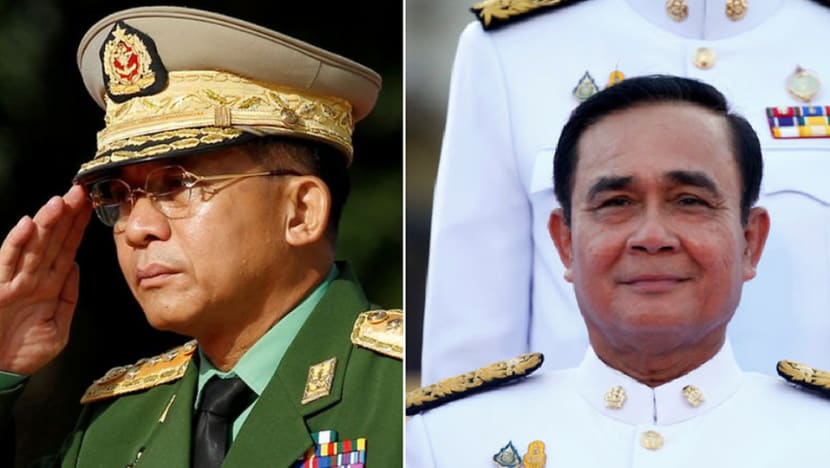
Composite photos of Thai Prime Minister Prayuth Chan-o-cha and Myanmar's General Min Aung Hlaing. (Photos: Reuters)
SINGAPORE: At first glance, one can see similar motives for the 2006 and 2014 coups in Thailand as well as the 2021 Myanmar coup.
In all three cases, coup-plotters faced popular civilian governments seeking more control over the military.
In 2006 General Sonthi Boonyaratglin confronted populist Prime Minister Thaksin Shinawatra. In 2014 General Prayuth Chan-o-cha faced Thaksin’s sister Yingluck.
In 2021 Myanmar military commander Min Aung Hlaing confronted Aung San Suu Kyi.
READ: Commentary: Myanmar protesters are not giving up so easily
With their compulsory retirements drawing near, these military leaders could have faced prosecution and lost their economic holdings as well as any political future.
Indeed, Thailand and Myanmar are both praetorian societies given that their militaries have always been leading national political actors.
In the name of national security, these militaries have possessed enormous state, economic and social power. When elected civilian governments led these countries, civil-military relations in Thailand and Myanmar have been fraught with extreme tension, often leading to coups.
THAILAND COULD HAVE BEEN MODEL FOR MYANMAR
General Min Aung Hlaing and other Tatmadaw leaders were certainly watching and taking notes when Thailand’s 2014 coup against a popularly-elected civilian democracy sustained itself into a military-dominated pseudo-democracy in 2019.
Arguably, following Myanmar’s Feb 1 coup, Myanmar generals appear to have sought to follow the Thailand model of military control.
That model suggests that militaries can successfully stage coups and guide democracy where strong central governments traditionally dominates but elected civilians cannot control militaries, courts side with the armed forces, and civilians are more divided than security officials.
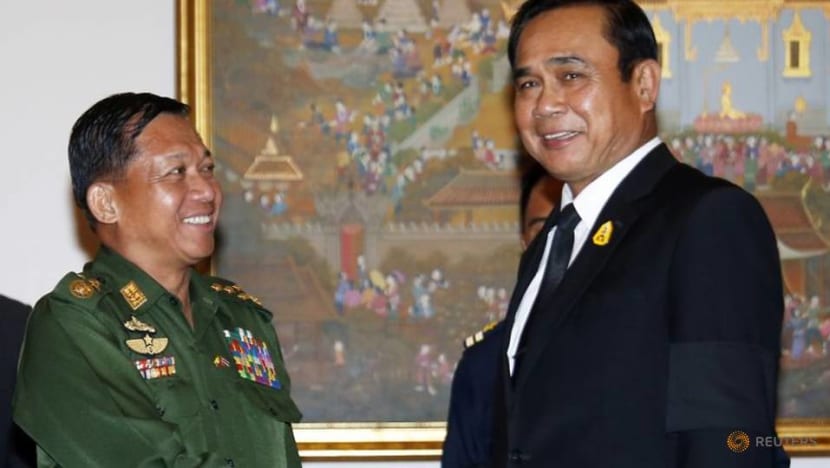
It is these instructive lessons which Myanmar’s military took from Thailand’s coups of 2006 and 2014. Following Thailand’s 2006 coup and enactment of a 2007 constitution which weakened civilian rule, Thailand witnessed six years of frail democracy.
From 2008 until 2014, elected Thai governments exerted little effective civilian control, invariably acquiescing to military preferences.
The feebleness of Thai democracy helped convince Myanmar’s military to enact its own 2008 constitution and hold 2011 elections. As in Thailand, post-2011 Myanmar governments exerted little control over the military, often deferring to it.
BUT MYANMAR WAS A STEP AHEAD
However, Myanmar’s military was a step ahead of Thailand. It controlled 25 per cent of legislatures in each House of Parliament, enjoyed autonomy from civilian monitoring of its economic holdings and dominated the National Defence and Security Council.
Thailand’s 2017 constitution impressed Myanmar’s military leadership. Thailand’s Senate, Election Commission and Constitutional Court were appointed by the military government, a new electoral formula preventing parties from obtaining Lower House majorities, and governments now had to abide by a 20-Year National Strategy to ensure enormous funding for the military or potentially face impeachment.
READ: Commentary: Can Myanmar’s civil disobedience movement overturn the coup?
Meanwhile, Palang Pracharat, a military proxy political party which utilised state resources, was created. Deputy Prime Minister (and retired General) Prawit Wongsuwan remains the party’s leader. The party has also employed local voter canvassing networks and offered welfare handouts to entice voters.
Learning from Thailand’s 2019 election and its use of a new constitution to entrench its position in politics, the Tatmadaw tried to modify the 2008 constitution to enhance military control.
But the National League for Democracy (NLD)-dominated Joint Parliamentary Committee for Constitutional Amendment vetoed these attempts.
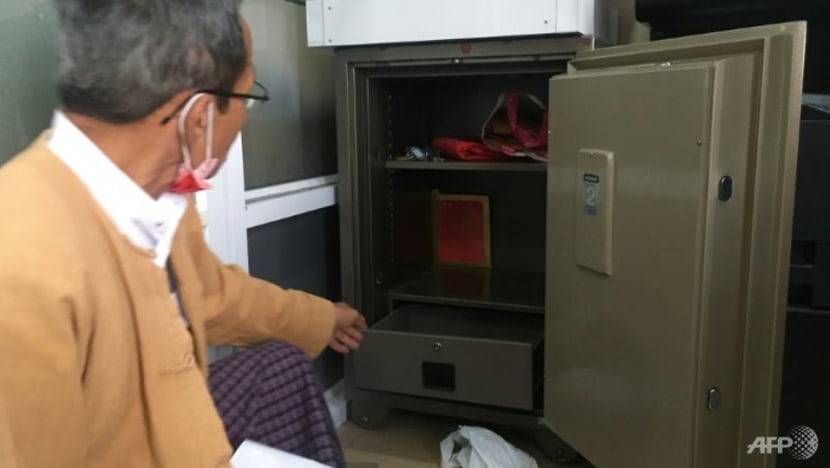
It is no surprise that the Tatmadaw looked longingly at Thailand. If Myanmar’s military leaders could implement a charter similar to Thailand’s 2017 constitution, then their proxy Union Solidarity and Development Party (USDP) might finally win an election against the NLD, propelling the military to electorally dominate the state.
But Myanmar’s November 2020 election result delivered another super-majority to the NLD, guaranteeing that constitutional changes would not be implemented anytime soon.
In a way, like Thailand’s 2014 coup allowed Thailand’s military a few more years to fix the constitution, Myanmar’s 2021 take-over tries to do the same.
BUT CLEAR DIFFERENCES REMAIN
There are differences between the Thai case and the situation in Myanmar.
First, Thailand has long been controlled by an arrangement between monarchy and military with the latter as junior partner. The military derives much power from legitimacy it possesses as guardian of monarchy, especially its closeness to late Rama IX (beloved by most Thais).
His enormous popularity and endorsement of 2006 and 2014 coups (amid Thai divisions regarding Premier Thaksin Shinawatra) left Thais divided but kept the balance skewed towards the military. On the contrary, Myanmar’s coup seemed to have provoked a massive domestic backlash.
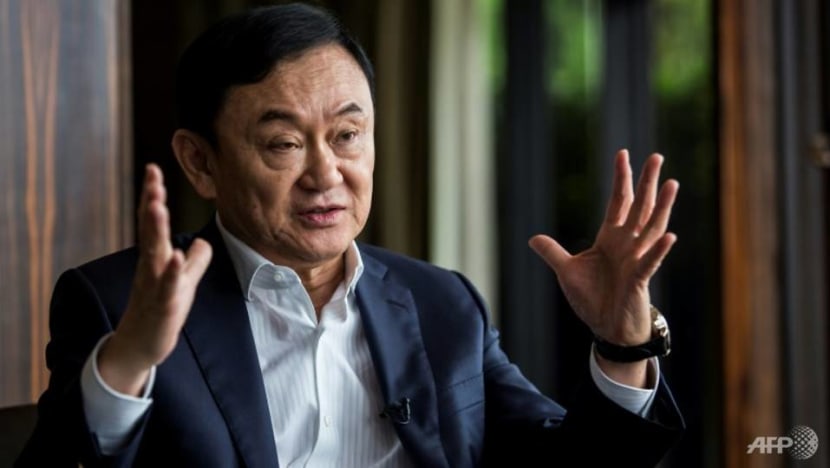
Second, having influenced the writing of at least 15 constitutions, Thailand’s military has taken a long path in finally succeeding in engineering political party dominance and gaining national primacy. It has entrenched itself into the political system.
However, in Myanmar, the senior officer corps has long perceived itself as the “rescuer” of the country from colonialism and foreign enemies, ensuring its persevering and privileged national security role.
READ: Commentary: Myanmar learnt the wrong lessons from Indonesia’s political transition
This viewpoint helped rationalise its 1962, 1988 and 2021 interventions. At the same time, Tatmadaw officers have become a privileged economic class — the most powerful nationwide.
But that sentiment is not shared by the general public. The country remains disunited, with few civilians enjoying popularity except for Aung San Suu Kyi.
Meanwhile, the military has been more successful at using brute force rather than constructing a successful political party. The death toll has risen sharply to more than 550.
BUILD SUPPORT WITHIN A PSEUDO DEMOCRATIC SYSTEM
Despite differences, the crucial implication of Thailand for Myanmar is that repression alone will not sustain military influence.
Having said yes to a democratic transition with elections since 2011, Myanmar’s military cannot allow democratic stirrings to commence only to eliminate them when it deems fit. That viewpoint ignores Myanmar’s 2011 to 2021 democratic transition.
It would be far smarter for the Tatmadaw to build support within a pseudo-democratic system — as Thailand’s military has done. Otherwise, Myanmar might proceed toward bloodstained national slaughter — reverting to its past.
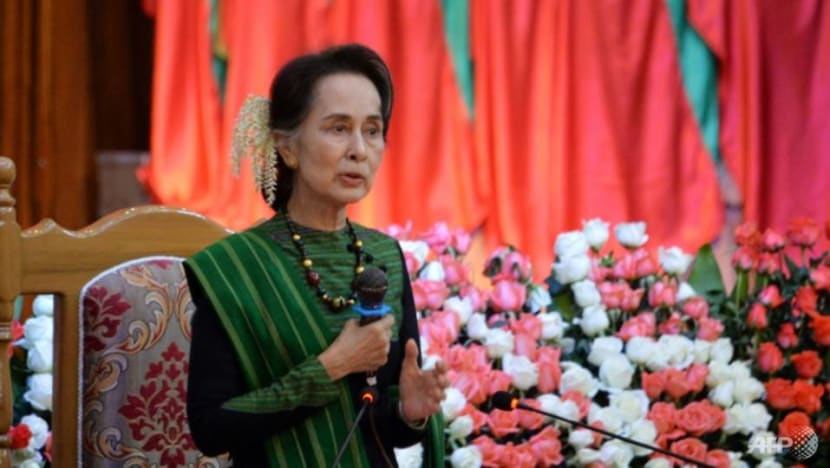
Now the die has been cast. With violent military repression unable to squelch the protests, what can the Tatmadaw do now? There are three paths.
First, give in to the protestors and revert to the pre-coup system parliamentary democracy.
Second, attempt a Thai model for Myanmar in constructing a new constitution which gives the Tatmadaw much more influence over a new pseudo-democracy.
Establishing such a bicameral political system, with a completely military-appointed Senate, Election Commission and judiciary as well as an electoral formula which, as in post-2019 Thailand, buffers the country against the scenario where any highly-popular party (whether Thaksin’s Pheu Thai in Thailand or Aung San Suu Kyi’s NLD in Myanmar) can translate a sudden electoral majority immediately into a complete parliamentary advantage.
READ: Commentary: Is China using Myanmar coup to ramp up influence in Southeast Asia?
READ: Commentary: Defiance in Myanmar’s diplomatic ranks threatens the military’s power
Third, revert to Myanmar’s pre-1990 election history of violent military dictatorship.
In April 2021, with the first scenario a non-starter and the second unacceptable by most in Myanmar, the country appears to have violently descended into scenario three - a dark tunnel of military subjugation. But with mass protests continuing, the February coup has not been fully successful.
Eventually, the Tatmadaw must realise that they will have to someday come to some sort of compromise with the NLD, which has gained overwhelming support.
The question remains: How many more people will have to die before it comes to the negotiating table?
Dr Paul Chambers is Visiting Fellow, Thailand Studies Programme at ISEAS – Yusof Ishak Institute












